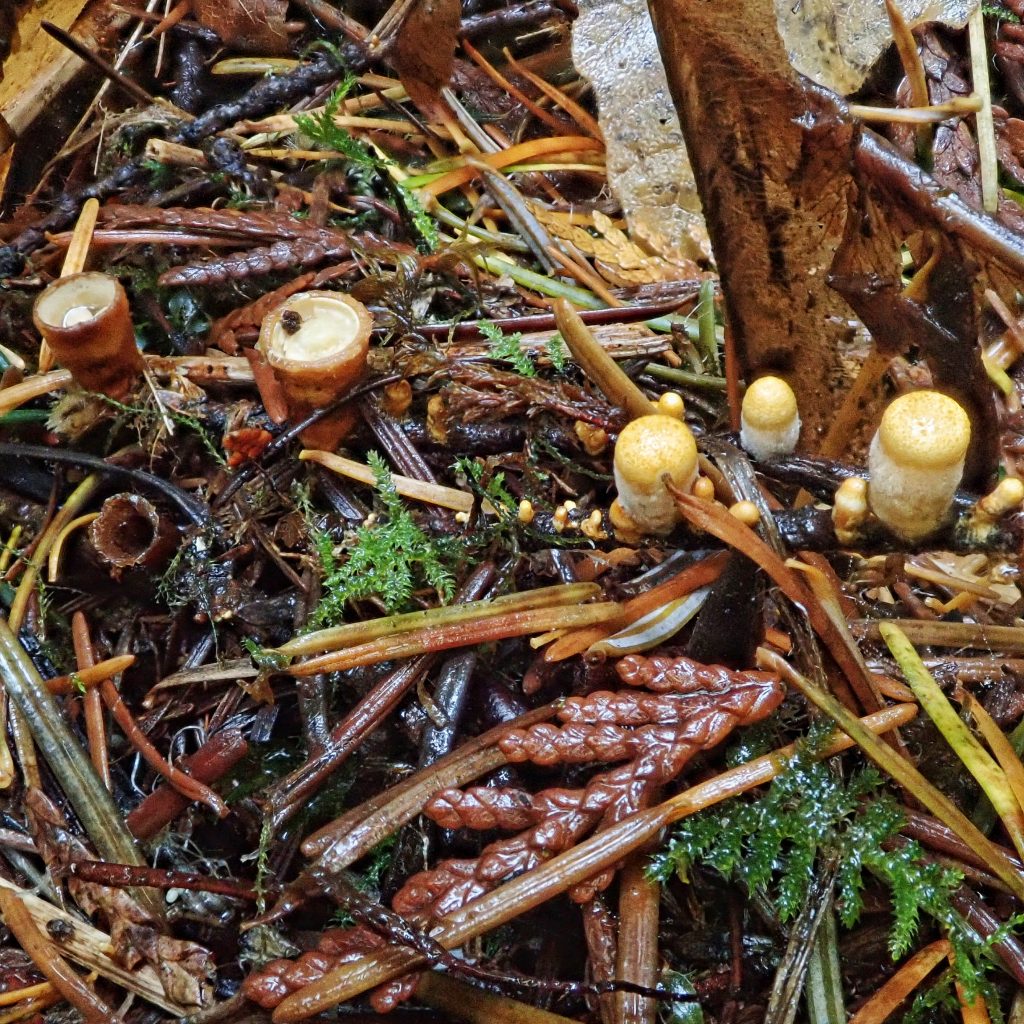
I simply love finding bird’s nest fungi (family Nidulariaceae)! I’ve been finding them more often since I’ve been down in the leaf litter and woody detritus looking for myxos and myriapods, though it’s mostly been Cyathus striatus or Nidula niveotomentosa. But when I saw the yellow caps (epiphragm) on these fungi, I knew I had something different. Because of the obvious funiculus (a tiny cord attaching the eggs [peridioles] to the nest [peridium]), the very smooth inner surface and fairly smooth, non-shaggy outer surface of the peridium, and those yellow epiphragm , it was pretty easy to identify this as Crucibulum crucibuliforme, using this key.
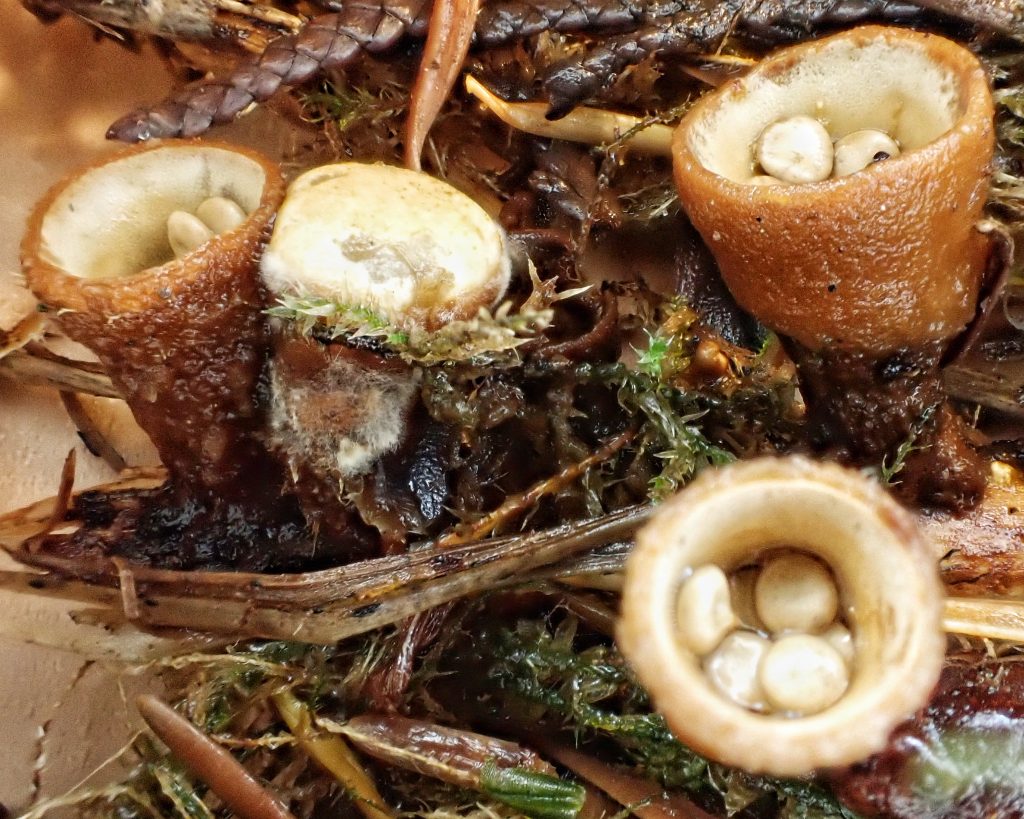
For bird’s nest fungi getting the eggs from the nest to a suitable substrate for germination is an involved process involving being splashed out of the cup by the force of falling raindrops, and I discuss this, and the function of the funiculus, in more general terms in the profiles of Cyathus striatus and Nidula niveotomentosa. In the case of Crucibulum crucibuliforme the purse that contains the funiculus is a rounded knob attached directly to the peridiole, and it is then attached to the wall of the peridium by a stout 2mm long cord. When water splashes into the cup it can eject the peridiole up to 4’ horizontally! In experiments by H. Brodie and A. H. R. Buller (H. Brodie; “The Bird’s Nest Fungi”; 1975) it was shown that Crucibulum crucibuliforme ejected its peridioles father than any other species tested, with the exception of Cyathus striatus.
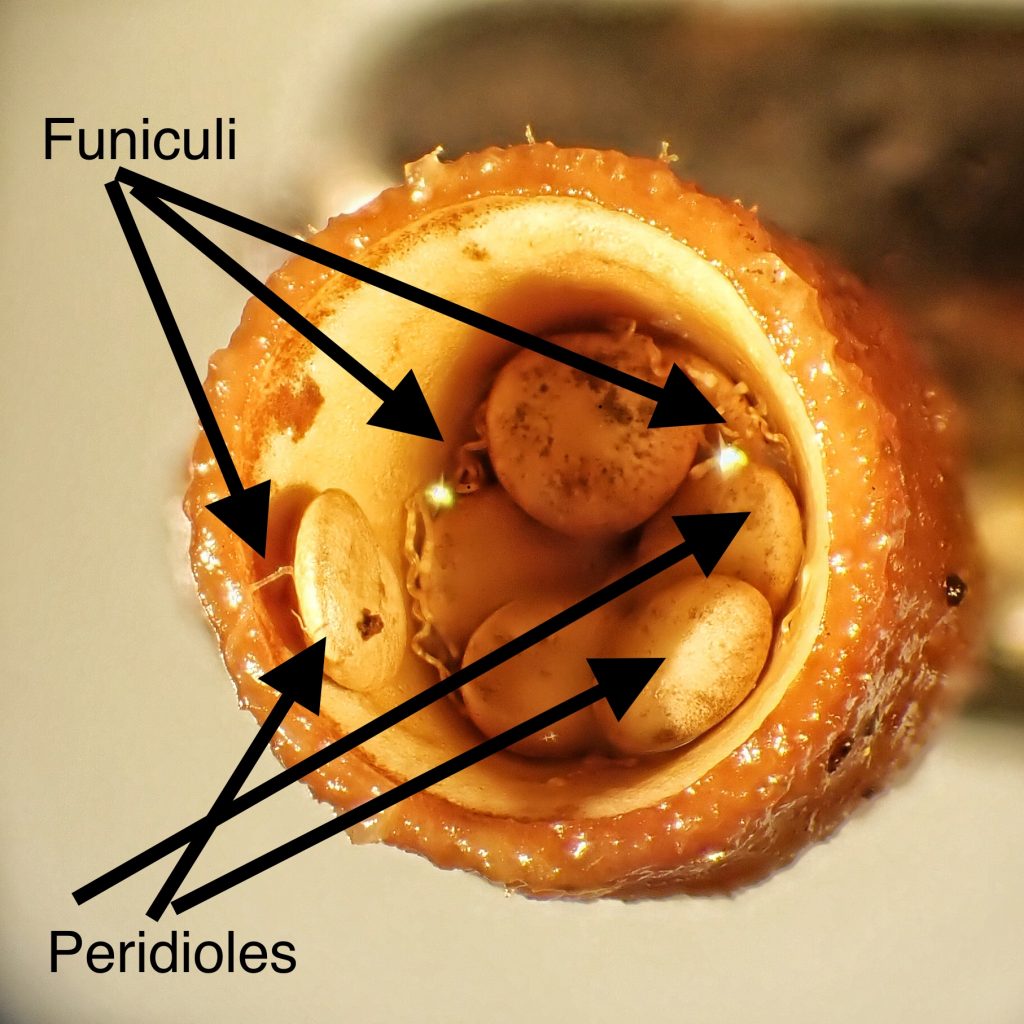
The peridioles contain the basidia, which form the spores. Unlike many other Nidulariaceae, Crucibulum crucibuliforme forms all of its peridioles at the same time. It is also unusual in that the epiphragm does not open because of growth of the peridium tearing it apart. It opens because the upward gelatinization of the interior of the cup finally consumes the lid. It has been assumed that the weathering of the peridiole eventually allows for the release of mature spores, but it is apparently still unknown for certain. It has been found that many peridioles are consumed on purpose or by accident by various herbivores, and spores are released in those cases, apparently remaining viable as they pass through the animal’s digestive system. And whole peridioles have been germinated in laboratory experiments, but whether that ever occurs in nature is also unknown.
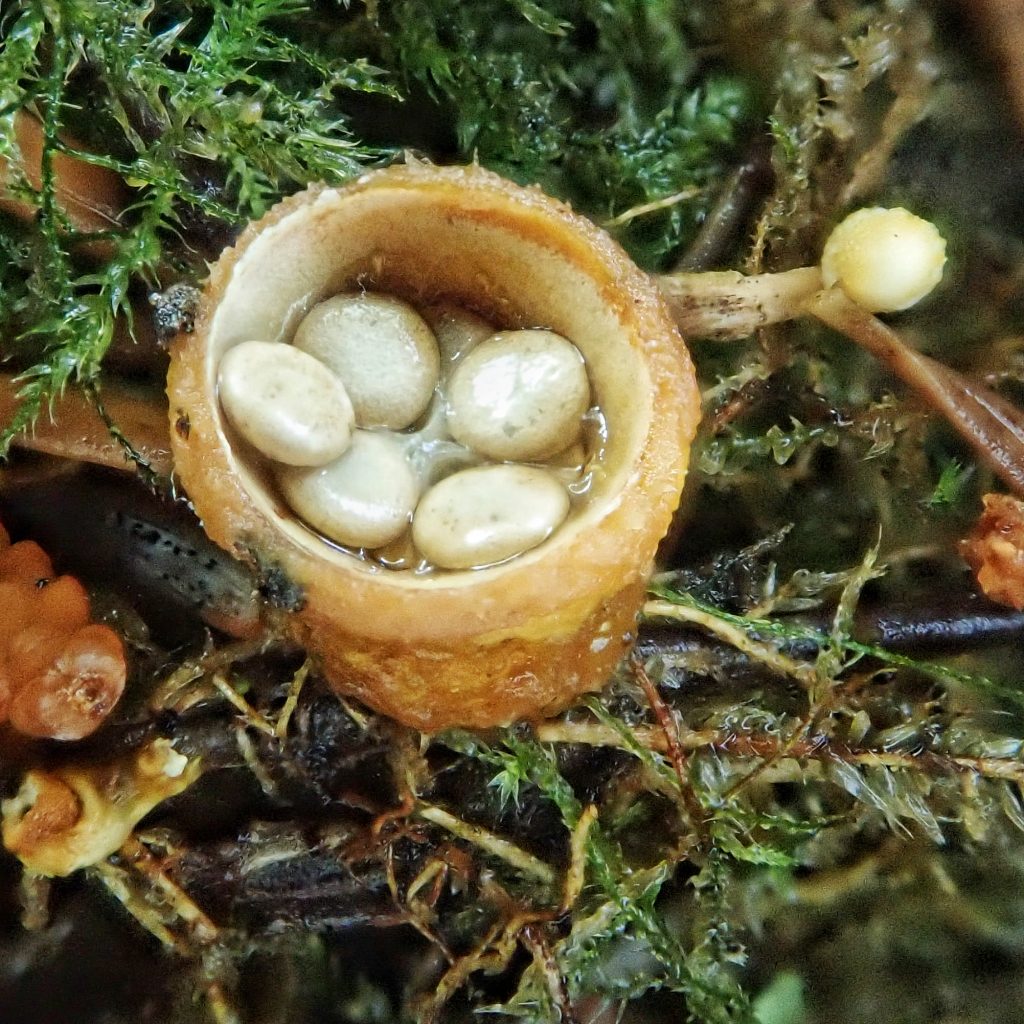
This species is sometimes called common bird’s nest fungi or white-egg bird’s nest fungi, but neither of these are really satisfactory names. Until recently this species was known scientifically as Crucibulum laeve, but that has recently been synonimized with C. crucibuliforme, and the latter had priority because of being named first. And there is more to this story, but I cannot access the definitive paper on the subject, “Molecular systematics and taxonomic overview of the bird’s nest fungi (Nidulariaceae)” (Kraisitudomsook/Healy/Smith; 2021), despite spending a couple of hours trying to do so by various means. I realize that it’s probably not an ivory tower issue. Publishers decide most of these things. But it is certainly yet another example of the detrimental effects of living in a world run by the religion of profit.
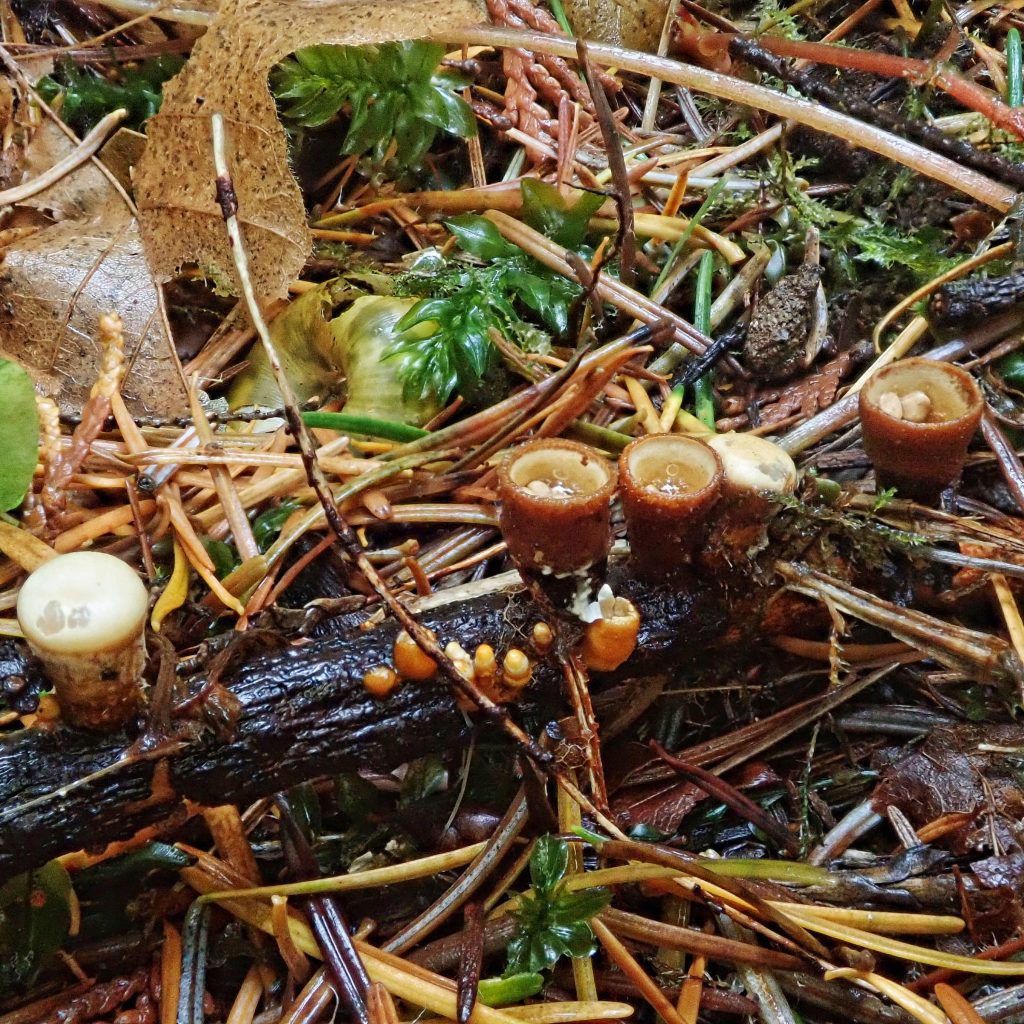
These beautiful and compelling saprotrophic fungi are a small but important part of the decomposition process in our forests and woodlands. And the more I learned about them the more weird and wonderful they seemed. They say these are the most common bird’s nest fungi in temperate North America, so I’m really looking forward to running into them again!
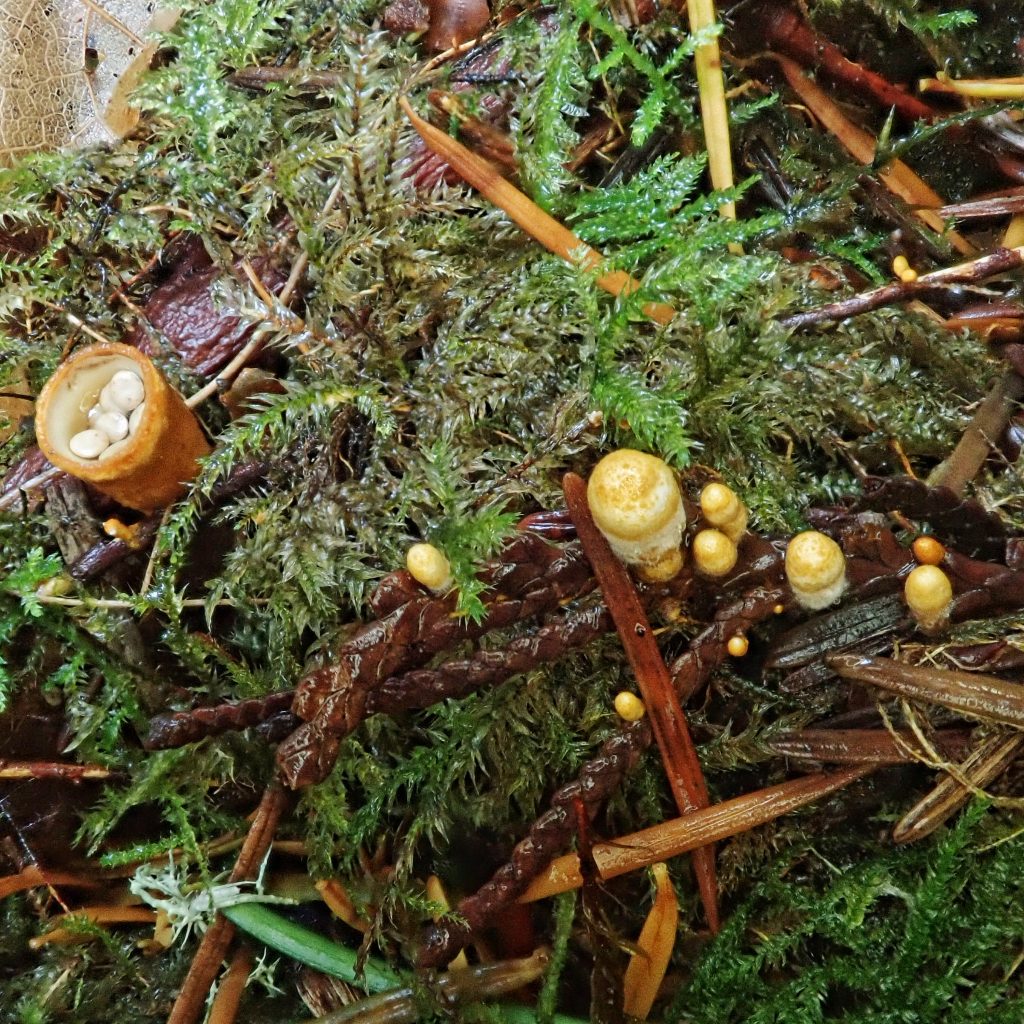
Description-Small (up to 9mm tall by 10mm wide, but usually smaller) cup shaped fungus with a smooth, cream to white interior wall, slightly wrinkled (rugose), yellowish brown, smooth to velvety, but never shaggy or hairy, exterior wall, and a yellow fading to buff epiphragm; immatures are globose with a bright yellow epiphragm; peridioles 1.5-2mm discs, grey to buff or white, connected to the peridium (cup) by a funiculus; purse connecting the funiculus to the peridiole is a nipple-like rounded knob.
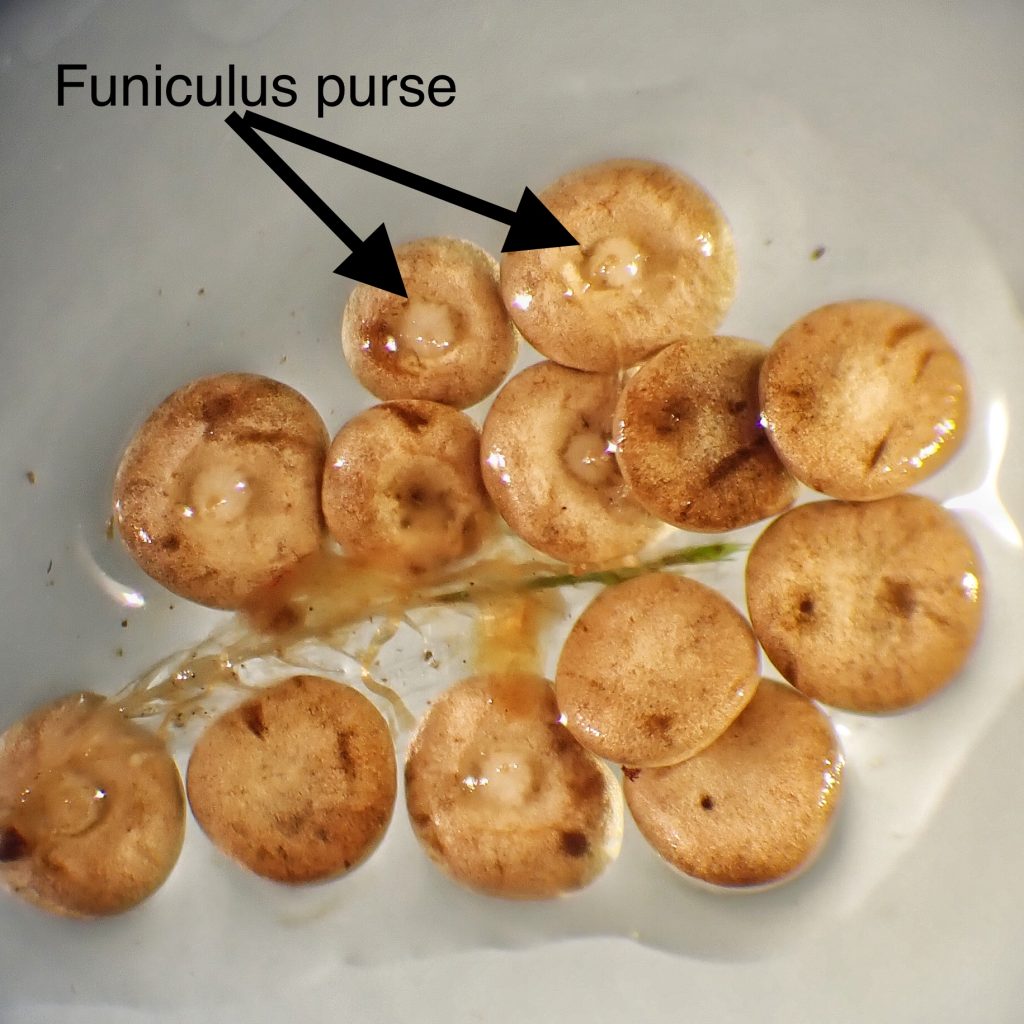
Similar species–Nidularia and Mycocalia spp. lack an epiphragm; Nidula spp. lack a funiculus; Crucibulum parvulum peridium are less than 3mm wide, and tend to be white to buff; Cyastus spp. have hairy, shaggy, or grooved exteriors, and the funiculus purse is an elongated sac.
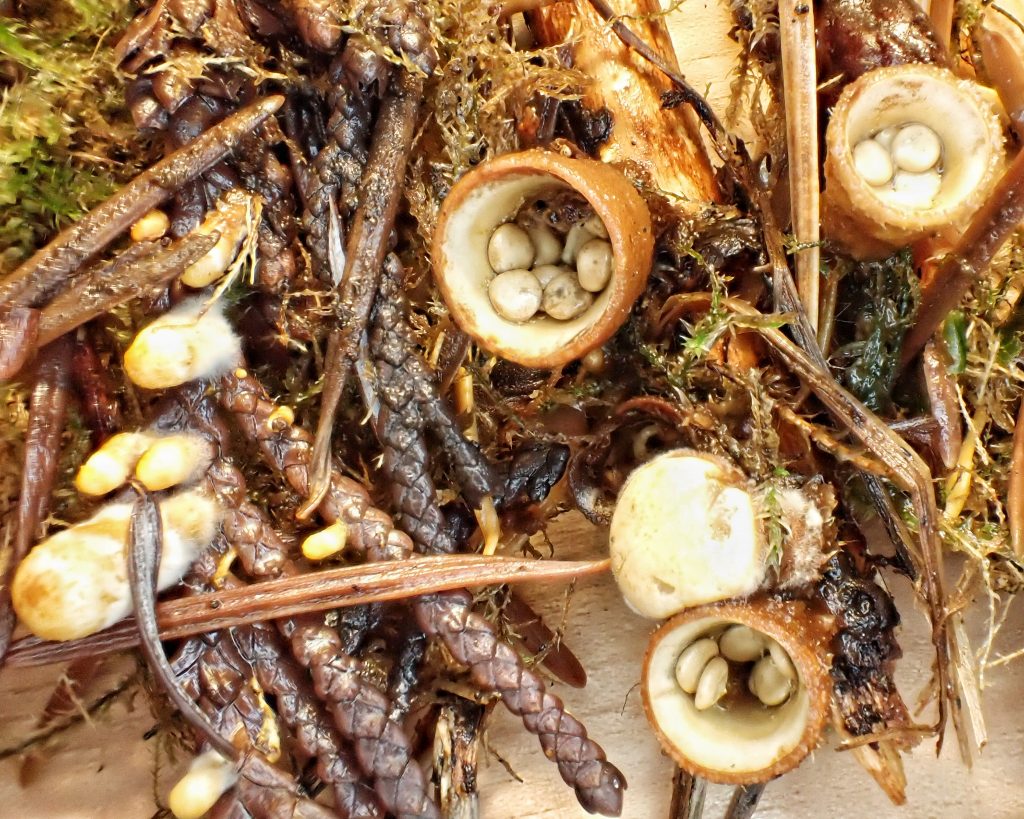
Habitat-Decaying woody debris, though seldom found on large logs; sometimes found in great numbers on prostrate cornstalks; not found on soil that lacks a woody content; occasionally found in herbivore dung.
Range-Temperate parts of both Northern and Southern Hemispheres; region wide in appropriate habitat, more common on the wetside.
Reproductive timing-Primarily in the fall in our region, although the tough, eggless peridium may be found nearly year around.
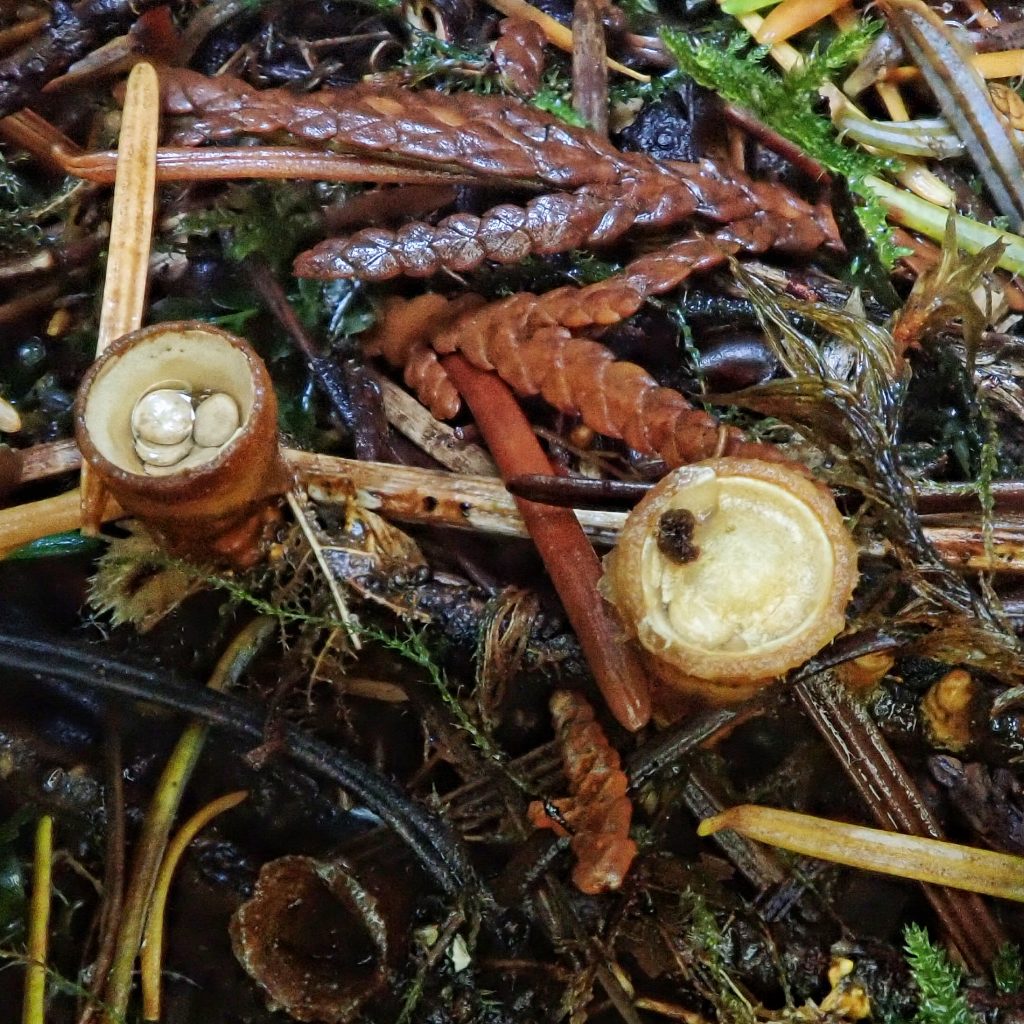
Eaten by-Slugs, snails, woodlice and mice eat the peridioles and the spores remain viable as they pass through their digestive track, aiding in the dispersal of this species; beetles in the families Leiodidae, Staphylinidae, Endomychidae, Tenebrionidae, and Erotylidae amongst others; probably larvae of flies in Mycetophilidae and Phoridae.
Etymology of names–Crucibulum is from the Latin word for ‘crucible’, referring to the shape of the cup. The specific epithet crucibuliforme is also from Latin and references the same thing.
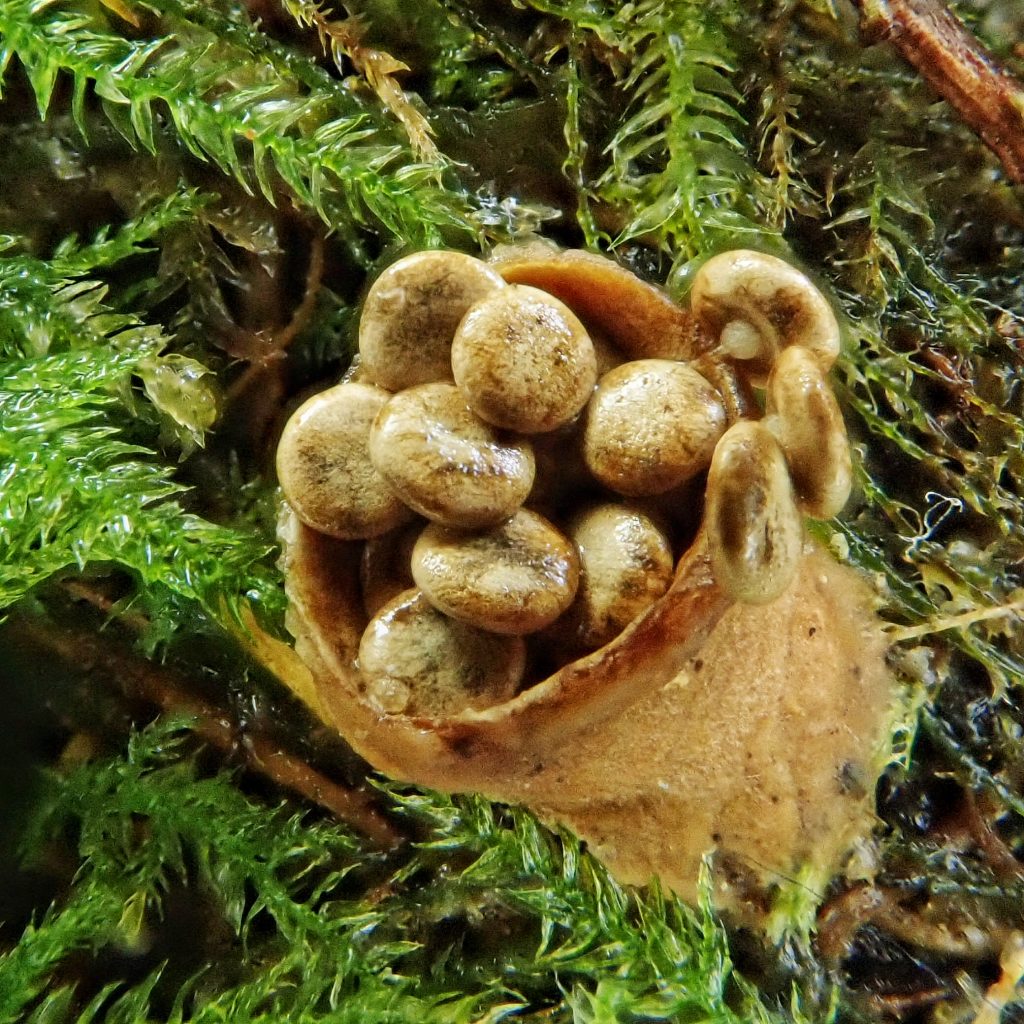
https://www.mushroomexpert.com/crucibulum_laeve.html
https://www.mykoweb.com/CAF/species/Crucibulum_laeve.html
https://www.first-nature.com/fungi/crucibulum-laeve.php
https://www.mushroomexpert.com/birdsnests.html
https://en.m.wikipedia.org/wiki/Saprotrophic_nutritio
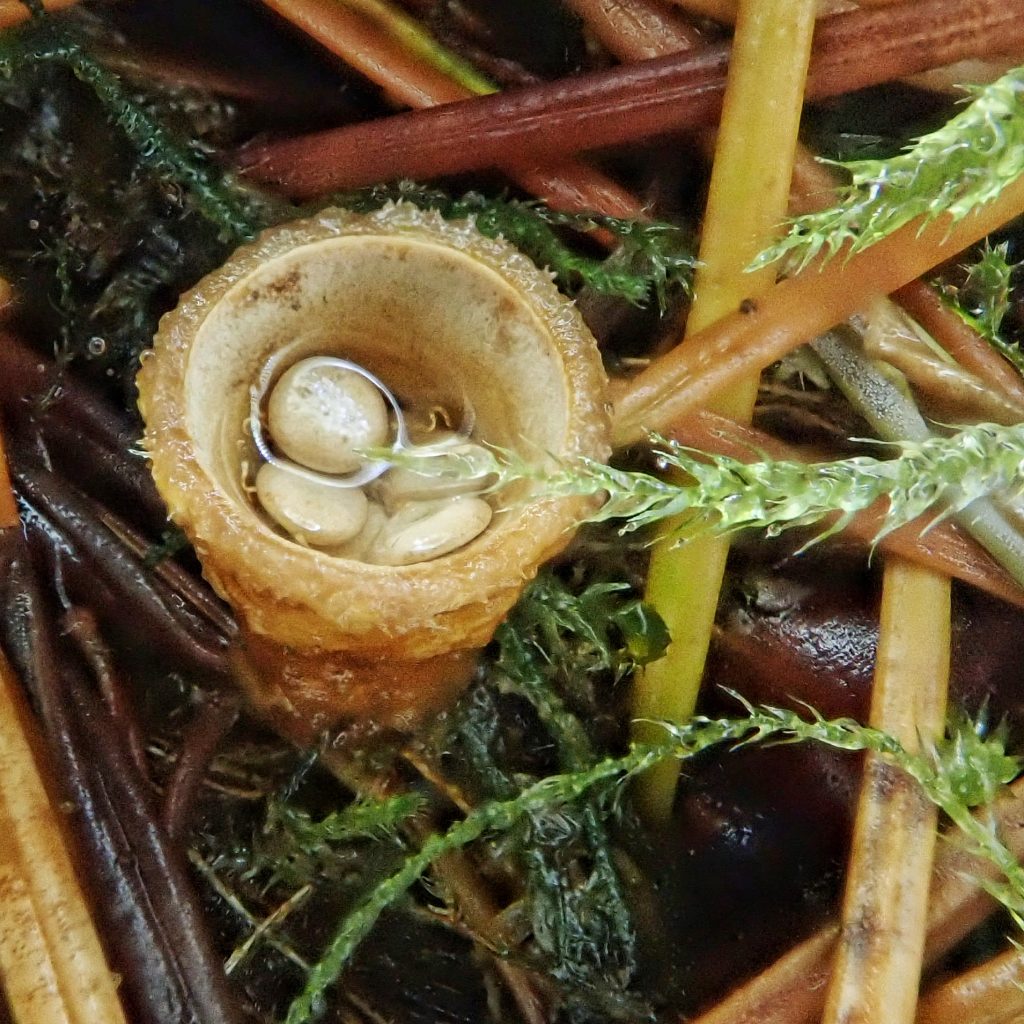
Hi Dan
OK, which is it – Crucibulum or Curucibulum? The former I suppose, yet the latter name crops up several times in this engaging account.
Thanks again for sharing your sense of wonder!
Crucibulum! I just can’t spell consistently. Thanks!
Fascinating! Thank you ☺️
This is my favorite of all your great posts since I started subscribing to this blog. I became interested in mushrooms because of the birds nest fungi, and today, after just reading this last night, I did a planned hike to Soapstone Lake in the coast range. I found what I think was this species, but unfortunately lost it on the hike as I had only my hat to hold it in. Will try again. Your pictures are spectacular and I am wondering what you use for magnification. I only have a hand lens at home and want to see inside the “cup”.
Thank you for your kind words, Pat! It thrills me to hear about people being able to use the information I find. I use an Olympus TG 5 for taking photos in the field. I can focus when very close, and it has focus stacking. At home I have a stereoscope and a couple of microscopes. A good handlers should work pretty well, but you may need to get external light on the subject. I have a lighted hand lens, but the optical quality isn’t great. I also use a nice hand lens and a headlamp for illumination. Good luck finding these cool fungi!